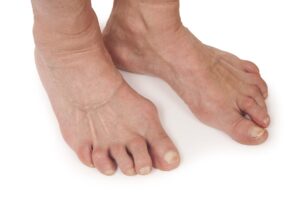
Hip Dysplasia: A Guide for Parents and Adults
Hip dysplasia (developmental dysplasia of the hip – DDH) is a condition that affects the hip joint.

Heel pain is a common complaint that we see in children and adolescents, especially those who participate in sports and activities that require a lot of heel involvement. The most common cause of heel pain in the younger population is calcaneal apophysitis (also known as Sever disease). Other conditions such as contusions and fractures can also be the cause of heel pain in your child. Heel pain can often interfere with sports and as a result parents will bring their children into our clinic so they can get back out onto the playing field as soon as possible. Keep reading for information about these conditions and how they are treated.
Calcaneal apophysitis (Sever Disease)
This is defined as an inflammation of the growth plate in the heel of growing children, usually adolescents. It is caused by repetitive stress to the heel over a prolonged period of time, hence being particularly common in active children. Several studies have revealed that this condition normally manifests between the ages of 5-11. Children going through adolescence also have an increased chance of developing Sever disease, as during this time the heel bone grows at a much faster rate than the tendons and muscles that attach to it. Pain usually resolves once the heel bone has completed growth. Studies have shown that symptoms related to Sever disease resolve within 2 weeks to 2 months.
Signs and symptoms of Sever Disease
Treatment options for Sever Disease
Treating Sever disease is simple in the majority of cases. With the immediate goal being relief of pain, limiting activities that involve running and jumping is essential. All other high impact activities are also discontinued during the initial phase of treatment, until the inflammation has decreased to a point where the stretching of the Achilles tendon is not painful. Once this has been achieved, your GP or podiatrist may recommend or prescribe the following for your child to continue the treatment protocol:
In some cases, orthotic devices can be prescribed after the acute inflammation has resolved to reduce the likelihood of recurrence.
Contusions (bruising) and fractures of the heel
Contusions and fractures make up a large chunk of other causes of heel pain in children and adolescents. Differentiation of these injuries to Sever disease is often simple as contusions and fractures are almost always a result of a high impact trauma to the heel and will often be a result of the child jumping from a great height onto a hard surface, often barefoot.
Signs and symptoms and diagnosis of contusions and fractures of the heel
Treatment of contusions and fractures of the heel
Contusions can be treated with rest, and then ice, heel cushion cups and cushioned footwear once the swelling has subsided. If you suspect that your child has fractured their heel(s) it is essential that you take them to your local GP or hospital so the appropriate testing and treatment processes begin immediately. Fractures require immobilisation of the heel to ensure that the bone heals correctly to prevent further complications from occurring.
What to do if you are unsure/worried about your child’s heel pain
With the return of community sports in Australia in the near future, please do not hesitate to come and see myself or Justin in the clinic. Our goal is to help your child return to playing the sport(s) they love as quickly as possible. We will take a thorough history of your child’s signs, symptoms and activities along with performing tests to determine what is causing the pain. Feel free to also leave a comment with any questions you have and we will aim to get back to you as soon as possible.
See you guys soon!
Richard – Sole-Lution Podiatry

Hip dysplasia (developmental dysplasia of the hip – DDH) is a condition that affects the hip joint.

Heel pain can be a real drag, especially when that first step in the morning feels like stepping on a tack. One culprit behind this discomfort can be heel spurs. But what exactly are they, and more importantly, how can you fix them?

Arthritis in the feet can significantly disrupt your daily life, turning simple walks into painful struggles.